Orchidectomy – Simple
Simple surgical removal of a sick or no functioning or painful testis, with/ without the placement of a prosthesis
Why is it done?
- To remove a symptomatic non-functioning testis.
- To remove remnants of a testis after destruction with abscess or infection / TB.
- To remove a shattered testis after severe trauma.
How is it done?
 This procedure is performed under general anesthetic.
This procedure is performed under general anesthetic.- A single incision is made on the midline raphe of the scrotum.
- The affected testis and vas deference is then extracted through this incision.
- The testis cord is then exposed as far as possible up in the inguinal area.
- The blood supply and the vas deferens is separated and tied and cut separately.
- The cord is tied off twice.
- The testis is then removed.
- The cord is checked for hemorrhaging.
- A drain may be placed
- A catheter may be left over night.
- A dressing is then applied, which should be removed after 72 hours.
- No strenuous movements are permitted for at least 14 days.
NB! You are required to bring 2 pairs of tight new undies for post-operative scrotal support.
What to expect after the procedure?
- Any anesthetic has its risks, and the anesthetist will explain all such risks.
- The drain will be removed the next morning.
- The catheter will be removed 6-8 hours after the procedure.
- A haematoma (blood collection under the skin or in the scrotal cavity) may form and needs to be reviewed as soon as possible. This may require drainage. Bruising is normal.
- An infection of the wound can occur and requires immediate attention.
- Owing to the nature of the surgery and the soft skin of the scrotum, bruising may appear to be much worse than it actually is and is no cause for alarm.
- DANGER SIGNS: A scrotum that swells immediately to size of a football, fever, puss. Contact Dr Schoeman or the hospital immediately as this may occur in up to 15% of all cases.
What next?
- The dressing should be kept dry for the initial 72 hours after surgery and then soaked in a bath until the dressing comes off with ease.
- The dressing may sometimes adhere to the wound causing slight bleeding on removal. Don’t panic, the bleeding will stop.
- Do not tug at the sutures!
- PLEASE CONTACT THE HOSPITAL DIRECTLY WITH ANY POST OPERATIVE CONCERNS AND RETURN TO THE HOSPITAL IMMEDIATELY SHOULD THERE BE ANY SIGNS OF SEPSIS.
NB! Regular self-examination highly recommended.
Download Information Sheet


Leave a Reply
Want to join the discussion?Feel free to contribute!